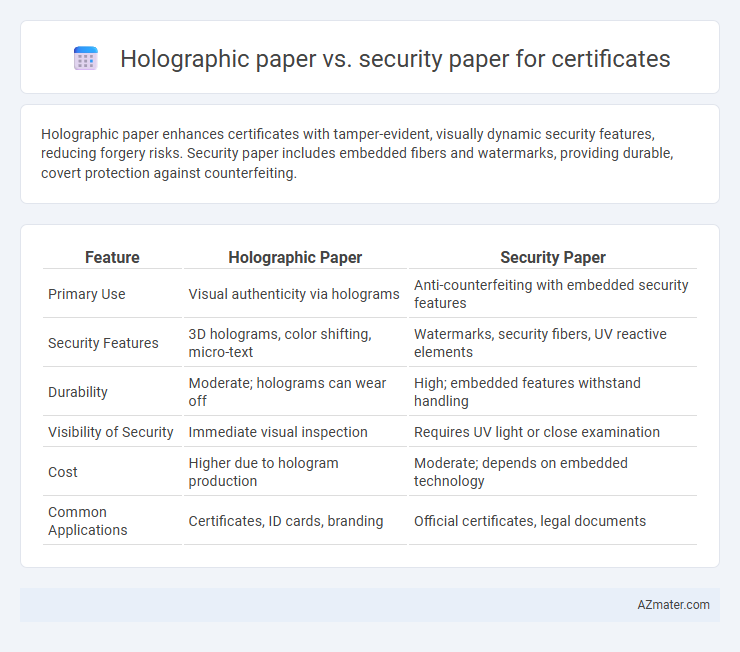Holographic paper enhances certificates with tamper-evident, visually dynamic security features, reducing forgery risks. Security paper includes embedded fibers and watermarks, providing durable, covert protection against counterfeiting.
Table of Comparison
| Feature | Holographic Paper | Security Paper |
|---|---|---|
| Primary Use | Visual authenticity via holograms | Anti-counterfeiting with embedded security features |
| Security Features | 3D holograms, color shifting, micro-text | Watermarks, security fibers, UV reactive elements |
| Durability | Moderate; holograms can wear off | High; embedded features withstand handling |
| Visibility of Security | Immediate visual inspection | Requires UV light or close examination |
| Cost | Higher due to hologram production | Moderate; depends on embedded technology |
| Common Applications | Certificates, ID cards, branding | Official certificates, legal documents |
Introduction to Certificate Security
Security paper provides foundational protection for certificates through embedded watermarks, microtext, and chemical fibers that resist forgery and tampering. Holographic paper enhances certificate security by incorporating visually complex, multi-dimensional holograms that are difficult to replicate and easily verifiable by the human eye. Combining both materials strengthens anti-counterfeiting measures, ensuring the authenticity and integrity of important certificates.
What is Holographic Paper?
Holographic paper for certificates features a laminated film embedded with 3D holograms that enhance security by making duplication and forgery extremely difficult. This specialized paper reflects light in various colors and patterns, providing a visually striking and tamper-evident layer that verifies authenticity. Used widely in official documents, holographic paper adds a layer of protection beyond traditional security paper, which typically incorporates watermarks, microtext, and other non-laminated features.
What is Security Paper?
Security paper is specially designed paper embedded with features such as watermarks, microtext, security fibers, and chemical sensitivity to prevent forgery and unauthorized duplication of certificates. Unlike holographic paper, which uses visible holograms for authentication, security paper provides covert protection by integrating intrinsic physical and chemical markers. These features make security paper a reliable choice for official documents requiring tamper-evident and counterfeit-resistant properties.
Key Features of Holographic Paper
Holographic paper for certificates features advanced optical security elements, such as multi-dimensional holograms that prevent counterfeiting and unauthorized duplication. Its surface incorporates dynamic light-reflective patterns visible from various angles, providing instant visual authentication without specialized tools. This paper type often integrates microtext and UV-reactive components, enhancing both aesthetic appeal and security compared to traditional security paper.
Key Features of Security Paper
Security paper for certificates features embedded watermarks, microtext, and chemical sensitivity to prevent forgery and unauthorized alterations. This paper often incorporates fibers visible under UV light and tamper-evident designs permanently altering when copied or scanned. Compared to holographic paper, security paper provides multi-layered protection through physical and chemical deterrents, enhancing document authenticity and integrity.
Comparison: Holographic vs Security Paper
Holographic paper features embedded holograms that provide a visually striking, tamper-evident layer ideal for certificates requiring high-level authentication. Security paper integrates multiple anti-counterfeiting elements such as watermarks, microtext, and UV fibers, offering robust protection against forgery. While holographic paper emphasizes immediate visual verification, security paper combines physical and chemical security features for comprehensive certificate protection.
Cost Analysis: Holographic Paper vs Security Paper
Holographic paper typically incurs higher costs due to advanced manufacturing processes involving laser-etched images and complex optical patterns, making it ideal for certificates requiring high-level authenticity. Security paper, often embedded with watermarks, fibers, and invisible inks, offers a more cost-effective option while still providing robust protection against forgery and tampering. Choosing between holographic and security paper depends on balancing budget constraints with the desired level of security, where holographic paper commands premium pricing but enhanced counterfeit resistance compared to security paper.
Durability and Counterfeit Resistance
Holographic paper offers superior counterfeit resistance through embedded holograms that are difficult to replicate, enhancing certificate security against forgery. Security paper provides enhanced durability with watermarks, fiber inclusions, and chemical-sensitive properties that prolong certificate lifespan under varied handling conditions. Combining both materials maximizes longevity and protection, ensuring certificates remain authentic and intact over time.
Applications in Certificate Issuance
Holographic paper enhances certificate issuance by providing advanced anti-counterfeiting features through embedded holograms that are difficult to replicate, ensuring authenticity and visual verification. Security paper incorporates specialized fibers, watermarks, and chemical sensitizers to prevent forgery and tampering, offering a robust physical safeguard for official documents. Both materials are critical in certificate issuance, with holographic paper excelling in visible authentication and security paper delivering foundational protection against cloning and alteration.
Choosing the Right Option for Your Certificates
Holographic paper offers enhanced visual security features that make certificates difficult to duplicate, using reflective patterns and embedded images. Security paper incorporates watermarks, microtext, and fiber threads to provide tamper-evident protection and authenticity verification. Selecting the right option depends on the level of security required; holographic paper excels in anti-counterfeiting, while security paper provides a stronger foundation for preventing forgery and ensuring certificate credibility.

Infographic: Holographic paper vs Security paper for Certificate
 azmater.com
azmater.com